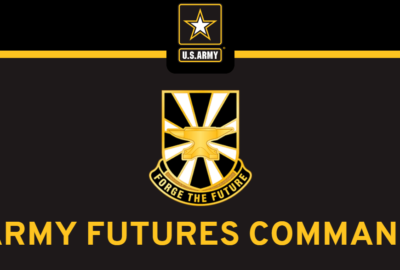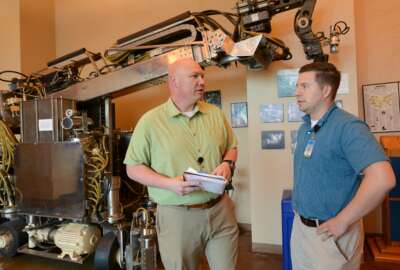
This Army command spends $100 billion a year
Not much can happen in the Army without the products and services that clothe, feed and equip the soldiers. Responsibility for acquiring most of what the Army needs...
Best listening experience is on Chrome, Firefox or Safari. Subscribe to Federal Drive’s daily audio interviews on Apple Podcasts or PodcastOne.
Not much can happen in the Army without the products and services that clothe, feed and equip the soldiers. Responsibility for acquiring most of what the Army needs falls to the Army Contracting Command. For an update at the Association of the U.S. Army conference in Washington, DC, the Federal Drive with Tom Temin caught up with the Contracting Commands Commander Brigadier General Christine Beeler.
Interview transcript:
Christine Beeler: So if you think about the Army’s total budget, and the amount it spends on contracts, Army Contracting Command obligates 93% of every obligated dollar in the Army. Last year in 2022, we ended this year with almost $100 billion in spend, the previous year was $102 billion.
Tom Temin: All right, and that’s a big figure. There’s also something called the Defense Logistics Agency. So where do you in terms of commodities or strategies? Where do you end and they begin?
Christine Beeler: So the Defense Logistics Agency buys, spares, repairs, uniforms and stuff kind of after we’ve already gotten it into the system. So a good example would be uniform items. So the Department of the Army will develop something new, will initially get the initial production and then future contracts will be done by the Defense Logistics Agency. And they’ll continue the big stockpile and the big build along those lines.
Tom Temin: By the way, uniforms seem to be a area of constant ferment in the military across all the branches, materials, colors, the type of camouflage, digital and all of these things. What’s going on at the moment if anything in Army uniforms?
Christine Beeler: Well I’m wearing the latest in the Army’s you know, fashionable class A uniform that is a throwback to a previous generation.
Tom Temin: It’s very sharp, by the way.
Christine Beeler: It is. I agree. The Program Executive Office for soldier, PEO Soldier, is responsible for the Army’s uniforms, designs, it’s also for all of the individual soldier kit, right, so the latest in helmets, the latest in body armor. You know, right now, the big thing is making sure we’ve got body armor that appropriately fits everybody in the service. So an area of particular interest, of course, is body armor that fits female soldiers better than the current body armor does. So all of those things are being looked at and designed and tested as we speak.
Tom Temin: So they develop it. And I guess this happens for all of the kit items, someone develops it with specialized knowledge. But then it comes to Contracting Command to find a vendor.
Christine Beeler:
We’re actually involved from start to finish. So concept and ideas will do contracting with industry partners that help us develop concepts and ideas for Army Futures Command. And then we’ll progress into perhaps prototyping and technology development and technology insertion, we’ll do those contracts as well. And then when things move into a full on program of record, we will do the contracts for those items also. So really from start to finish, an Army contracting organization is involved in in those procurement actions.Tom Temin: And I imagine you must be able to help the process for example, in any of the materials areas in the world of manufacturing. It’s hard to source in the United States for some things like getting back to uniform; certain textiles. And so does the contract and command maintain the type of knowledge base that a operating unit might need to know but don’t develop that way because it’s only available in China, for example, some item?
Christine Beeler: So again, that’s at the beginning, right? There’s a lot of research that OSD does, that DoD, that the Army does to try and make sure that as we’re looking at new technology, new capabilities, we’re really making sure we’re sourcing not only U.S., right, so Buy American Act is a is a big deal. And we really, really strive to make sure we are achieving those goals and objectives, but also our mission partners, so you know, Canada and Mexico as part of a partnership, and then our allies and partners in Europe and really around the world. So it’s it is a global supply chain. And our job is to help reduce that risk also.
Tom Temin: We’re speaking with Brigadier General Christine Beeler. She is commander of Army Contracting Command, and you’ve got an effort going on called the Virtual Contracting Enterprise. And that seems pretty important because there’s a video of it on the website and tell us what it is and what you’re trying to accomplish.
Christine Beeler: So, Virtual Contracting Enterprise is a suite of tools that really enables our contracting professionals to do everything from electronic repository of the documentation that goes into contracting all the way through data analytics. And so we’re really trying to make sure we can harness the power of the data we have to help make better buying decisions in the future, and to really help all of the army units, see what they’re spending, how they’re spending, and are there better ways for them to look at their requirements? Not just to make them smaller, perhaps or less expensive, but are they getting what they thought they were getting when they went into the initial contract? And so by using these tools, we’re providing some power of knowledge into that so that commanders can make informed decisions on how they want to spend their money.
Tom Temin: And do these tools apply only to strictly Army one-off contracts? Or are they used against, say, some of the GWACS or some of the DoD-wide acquisition vehicles?
Christine Beeler: So, the beautiful thing about these tools is if the data exists in the system, right? So think of fed biz ops, or think of FPDS-NG, so the federal procurement data system next generation, it’s a repository of information, if we can get to the data, we can pull that information in and help use that for future decisions, we can see all the contracts, we can tell you how long it took from the time we started going down the acquisition lifecycle process, to the time we get in on award, to the time we actually get it into the hands of soldiers. So that’s the beauty of the data.
Tom Temin: And in general, how much does the Army use some of the civilian GSA types of contracts for just ordinary non-military commodities that you need in great volume?
Christine Beeler: Yeah, so we use GSA all the time. So in my mind, it should be any available contract, any available requirement, any available KO, let’s make sure we’re using the best tool that exists to get to what soldiers and commanders need. Today, tomorrow and in the future. So for my perspective, GSA is an awesome business partner, DLA awesome business partner, the Navy, awesome business partner, and the Air Force, awesome business partner. We all work collectively, to deliver the best stuff for the soldiers, the airmen, the Marines, the guardians, you name it, we’re one big team, we just have different ways about how we approach it.
Tom Temin: And we should point out the jacket you mentioned is olive, its not purple, but spoken in a good, true purple manner. And finally, I wanted to ask you how the contracting command interacts with, say, the futures command for those elements of the military that are looking at the innovative part and the non-traditional types of contractors to get that new technology, and how do you interact with them and make sure that Contracting Command is is there?
Christine Beeler: So the beauty of Army Contracting Command is we have always been partnered with all of those organizations. So when Army Futures Command stood up, we looked at, we did good military-decision making and analysis and we said, Okay, well, these products align with these contracting centers. And so we made sure that there was a contracting organization tied to each and every one of Army Futures Commands, programs and CFTs. So that it was seamless, it would go from Futures Command and ideas, all the way through to program of record if it made it that far, right, because the idea is fail fast, and make quick wins so that we can move stuff to soldiers sooner. Which we are going to deliver quite a few of the Army’s future requirements in the next two years. And so that went straight to the same contracting organization that would then write the contracts to deliver not only the production, the low rate production, but future production as well.
Tom Temin: And I imagine there’s a lot of activity going on right now just simply to replenish certain commodities and stocks, because of what we have shipped to Ukraine.
Christine Beeler: There is absolutely a lot of activity going on. So if you think about what we have, what the President has authorized us to send, plus what our partners are sending, we’re seeing an influx in recapitalization of Army stocks, but we’re not buying the old stuff, right. So if there was a new item that was going to be produced to replace the item we have, we have given to Ukraine, and we’re going to buy the new stuff. And so that’s kind of the way we’re continuing to move forward in that process.
Eric White: Brigadier General Christine Beeler is commander of the Army Contracting Command speaking with Tom Temin at the Association of the U.S. Army conference in Washington, DC.
Copyright © 2025 Federal News Network. All rights reserved. This website is not intended for users located within the European Economic Area.
Tom Temin is host of the Federal Drive and has been providing insight on federal technology and management issues for more than 30 years.
Follow @tteminWFED





